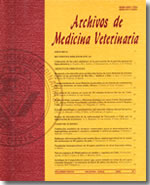Argentine ant Linepithema humile Mayr, 1868 (Hymenoptera: Formicidae) and its role as a possible vector of microbial contamination in a dairy goat farm Capra hircus Linnaeus, 1758 (Artiodactyla: Bovidae)
Main Article Content
Abstract
A bacteriological study of ants was conducted. The ants were captured in a dairy goat establishment located in Metropolitan Region. 63 samples were obtained and grouped into: 21 control samples aspirated directly on the sterile filter paper, prior to the passing of ants (Control A), 21 ant samples aspirated from the filter paper (Ants Sample), after removal of the ants from the aforementioned filter paper, 21 samples were obtained after the passing of ants (Control B). A microbiological protocol specifically designed for this study was used. The methodology included sowing in nutritious, selective and differential culture media. Subsequently, and depending on the organism biochemical tests or specific tests followed in each case. In this study it was decided to investigate the presence of 6 important pathogenic agents: Staphylococcus aureus, Salmonella spp., Pseudomonas aeruginosa, Escherichia coli, Listeria monocytogenes and Campylobacter jejuni. Four potential pathogens were isolated from the Ants Samples and the Control B Samples:Staphylococcus aureus, Salmonella spp., Pseudomonas aeruginosa and Escherichia coli. Also, other microbial agents were found such as Streptococcus sp., Micrococcus sp., Escherichia vulneris, Hafnia alvei, Serratia marcencens biog.1, Ewingella americana, Providencia rettgeri, Bacillus sp., Enterobacter aglomerans, Stomatococcu ssp., Morganella morganii. Control A samples were negative to microbial growth. Ant cultures were positive in 95.23%, while Control B samples showed bacterial growth in 90.47% of the cases. Linepithema humile, is capable of carrying microbial agents in a dairy goat farm.

